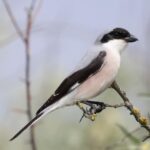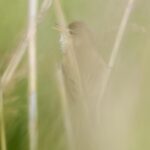Day 3 of a three day long weekend of tours today, our last day. It was another bright, sunny and warm day, great weather to be out birding on the coast. It felt almost like summer at last!
We met in Wells and headed west along the coast to Titchwell. When we arrived, the main car park was already filling up fast, so we parked in the overflow car park, which was still relatively quiet. We decided to have a quick look round to see what we could find before it got too busy.
There were lots of finches in the bushes. We flushed a couple of Greenfinches from the brambles, a Chaffinch perched up in a dead tree in the morning sun and a small group of Goldfinches circled over. A series of plaintive calls alerted us to a couple of Bullfinches flying over. One Bullfinch was left behind, a male, and followed on after the others, flashing pink underneath in the sunlight.
But the real surprise was to follow. Another bird flew up from the trees – it immediately looked bigger, heavier, short-tailed and when we got it in our binoculars we could see a bold white bar through the middle of the wings and a large bill. It was a Hawfinch! It circled round over the car park so we could all get a good look at it, then flew off high to the east. Hawfinches are rare birds in North Norfolk these days (we have a breeding population in the Brecks still), so this was a migrant, possibly fresh in from the continent. A great one to see!
A Blackcap was a bit more of a predictable find here, but still a nice bird to catch up with, particularly as we got a good view of a male, which was flitting around and feeding in the brambles. A small group of Swallows flew over the car park, heading west. These were the first we had seen this weekend. Most of the Swallows have already gone, but there were still a few on the move today, on their way to Africa for the winter.
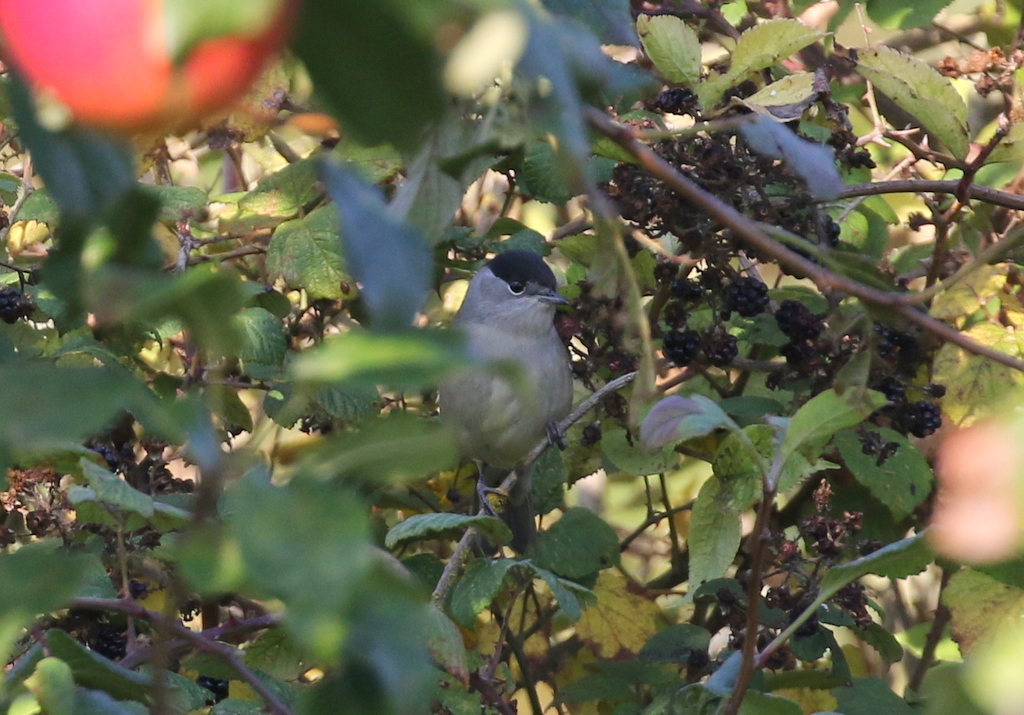 Blackcap – a male, feeding in the brambles in the car park
Blackcap – a male, feeding in the brambles in the car park
There had been a Pied Flycatcher and a Yellow-browed Warbler reported here yesterday, so we kept our eyes open for them today. The former had been seen in the picnic area but it wad all quiet as we made our way past this morning. We had a quick look at the feeders on our way past, which produced a selection of Chaffinches, Greenfinches and Goldfinches, Blue Tits and Great Tits.
We decided to walk along Fen Trail first, to see if we could find anything in the trees. We did find a flock of tits in the sallows. We could hear a couple of Chiffchaffs and a Goldcrest calling, but there was no sign of anything else with them.
Continuing on to Patsy’s Reedbed, we sat down at the screen and scanned the water. There was a nice selection of ducks on here, Gadwall, Shoveler and Teal. This is also a good place for diving ducks at the moment, and we added Common Pochard and Tufted Duck to our weekend’s list. There were three Little Grebes diving out on the water too. A Marsh Harrier quartered over the reeds beyond.
Another small group of six more Swallows flew in while we were sitting at the screen and continued on west. As we walked on along East Trail, another Swallow came in and circled over our heads. But that was all the hirundines we were to see today, and the small movement of Swallows dried up as the morning progressed.
Round at the end of Autumn Trail, there were three juvenile Ruff on the mud down at the front. One was noticeably darker brown than the others – they are very variable! It was an early high tide today and a big tide, so we thought we might find some Spotted Redshanks roosting on the freshmarsh. Sure enough, there they were, seven of them. They were mostly fast asleep, although occasionally one would wake up and flash its needle fine bill. There was a Common Redshank asleep with them and despite the fact we couldn’t see much of it, we could still see that it was much darker, greyer, than the Spotted Redshank next to it.
Just as we were all getting onto the Spotted Redshanks, which involved walking back a short distance along the path to be able to see obver the reeds, we heard Bearded Tits calling and looked back to where we had just been standing to see three of them climbing up the reed stems, two smart males and a female. Half the group raced back to get a closer look at the Bearded Tits, while the other half stayed put watching the Spotted Redshanks. A Water Rail squealed from deep in reeds too.
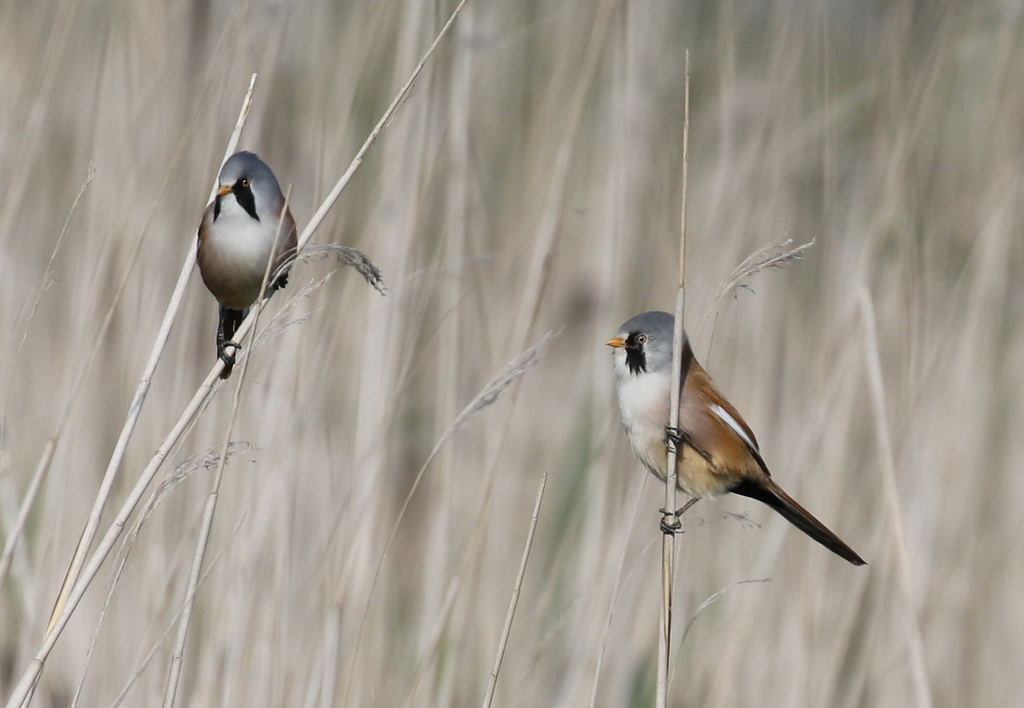 Bearded Tits – 2 of the 3 which showed well at the end of Autumn Trail, both males
Bearded Tits – 2 of the 3 which showed well at the end of Autumn Trail, both males
As we walked back along the path, a Sparrowhawk came over our heads, flapping and gliding, and disappeared into the sallows. A Kingfisher flew across from the direction of Patsy’s, over the path in front of us and disappeared over the hedge, too quick for most of the group to get onto unfortunately. It seemed an odd direction to be heading, there are only fields that way. We made our way slowly along Fen Trail and round onto Meadow Trail, scanning the trees, but there was nothing of note in the sallows beyond the usual tits and a couple of Chiffchaffs. A Sparrowhawk flushed from the trees ahead of us, possibly the one we had seen earlier.
As we got out onto the main path and clear of the trees, a small group of people were looking out across the grazing marsh. A Whinchat was perched on the top of a large bramble clump. We got it in the scope and had a good look at it, admiring its well marked supercilium, before it flew down into the grass and disappeared. A distant Common Buzzard was perched on a post at the back.
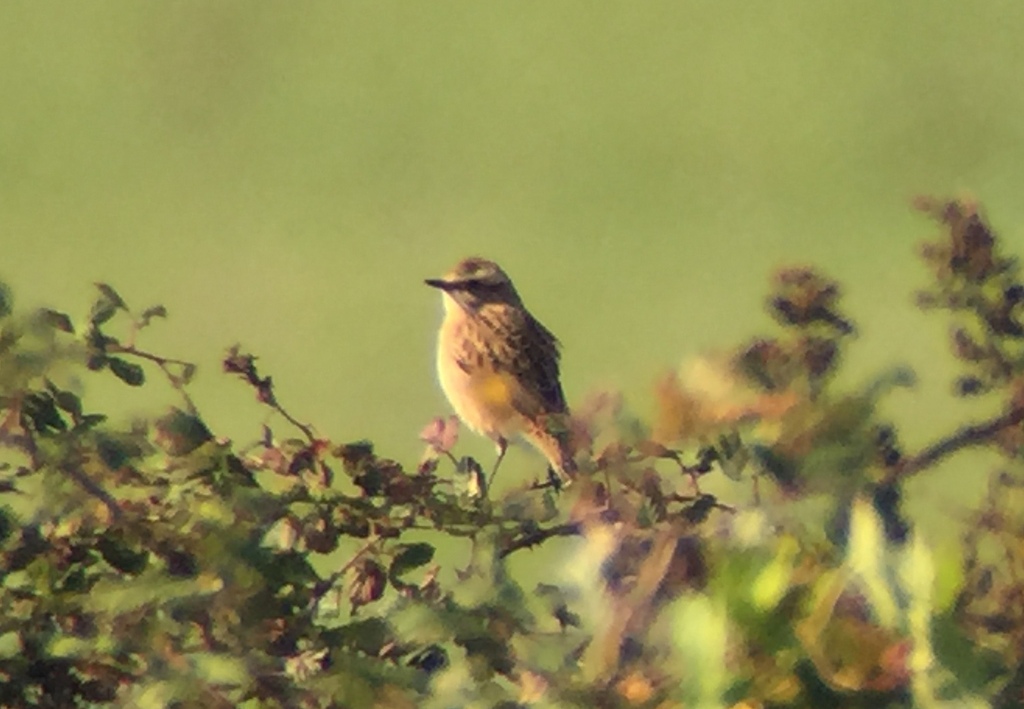 Whinchat – perched on the brambles out on the grazing marsh
Whinchat – perched on the brambles out on the grazing marsh
The Thornham grazing marsh pool still looks rather sad with very little water on it, but there was a lone Stock Dove out there today. The reedbed pool held just a group of Mallard, but the drakes are looking rather smart already, as they emerge early from drab eclipse plumage. Another Kingfisher called and flew round twice over the reeds – this time everyone got onto it and had a good look. A single Grey Plover was on Lavendar Pool.
Out at Island Hide, there were more Ruffs right in front of the hide. There were several juveniles but also one or two paler, grey/white adults. The adult Ruffs were rather aggressive towards the juveniles, chasing them out of their particular area of mud if they strayed too close. There were both male and female Ruff too, the females being considerably smaller, just to add to the confusing array of plumages.
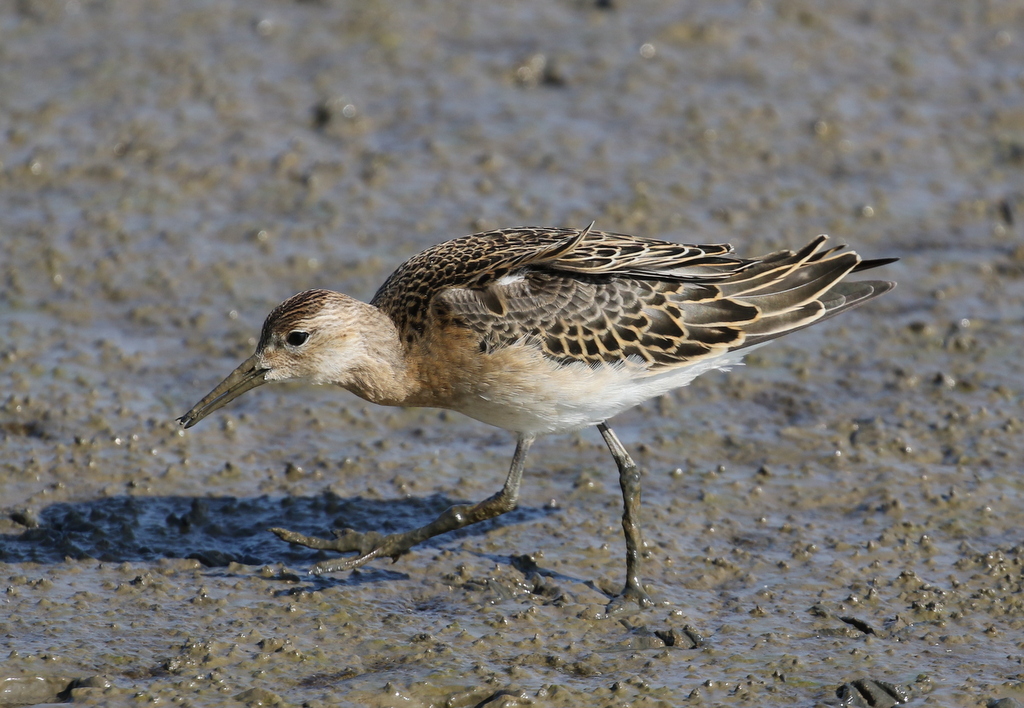 Ruff – a brown juvenile, feeding in front of Island Hide
Ruff – a brown juvenile, feeding in front of Island Hide
There were other waders too. Three Avocet out in the middle were our first of the weekend. Most of the Avocets which bred here, or came here post breeding, have gone already, most likely down to one of the estuaries further south in UK. A long line of Godwits, mostly asleep, included lots of Bar-tailed Godwits which had flown in from the beach to roost over high tide, and a good number of Black-tailed Godwits with them. There were a few Golden Plover standing around on the islands too.
Two Little Stints were with a couple of Dunlin in amongst the ducks on one of the islands. They were a little distant, but we had a good look at them through the scope. Then we looked across to the edge of the reeds and saw another Little Stint tucked in on the edge of the vegetation. Just at that moment, something spooked it and it flew out and landed in with a flock of Lapwings in the muddy water just out from the shore. Compared to the Lapwings and Redshanks next to it, we could really see just how tiny the Little Stint was.
 Little Stint – looked really tiny in with the much larger Lapwings
Little Stint – looked really tiny in with the much larger Lapwings
One of the group had asked about Yellow-legged Gulls earlier and we managed to find one today. It has been hanging around Titchwell on and off for a while now, and was in its usual place on one of the islands. Unfortunately, the Yellow-legged Gull was fast asleep, sat down on the mud so we couldn’t see its legs! One clue to its identity was the shade of its mantle, noticeably darker than the Black-headed Gulls all around it.
There are plenty of ducks out on the freshmarsh again now, mostly Wigeon and Teal which have started to return in numbers from their breeding grounds. The drakes are all in their drab eclipse plumage at the moment. There are more Brent Geese around too now, and we saw several small group flying in and out between the saltmarsh and the freshmarsh today.
There was not enough time to get out to the beach and back in time for lunch, so we made our way back from Island Hide, planning to come out again afterwards. The Pied Flycatcher had been reported here earlier but there was no sign now. We scanned the trees while we ate, just in case.
After lunch, we set out again to walk out to the beach. As we passed the reedbed, a Hobby zipped through, low between the bushes. We could hear more Bearded Tits pinging in the reeds. We had a quick look at the freshmarsh again, but there was no sign of anything new having arrived since we last looked.
There were a few more waders on the Volunteer Marsh today. The first bird we set our eyes on was a Lapwing, right down on the front corner of mud, just below the path. It looked absolutely stunning in the sun, its upperparts shining metallic green,bronze, purple as it caught the light. They really are one of our smartest birds!
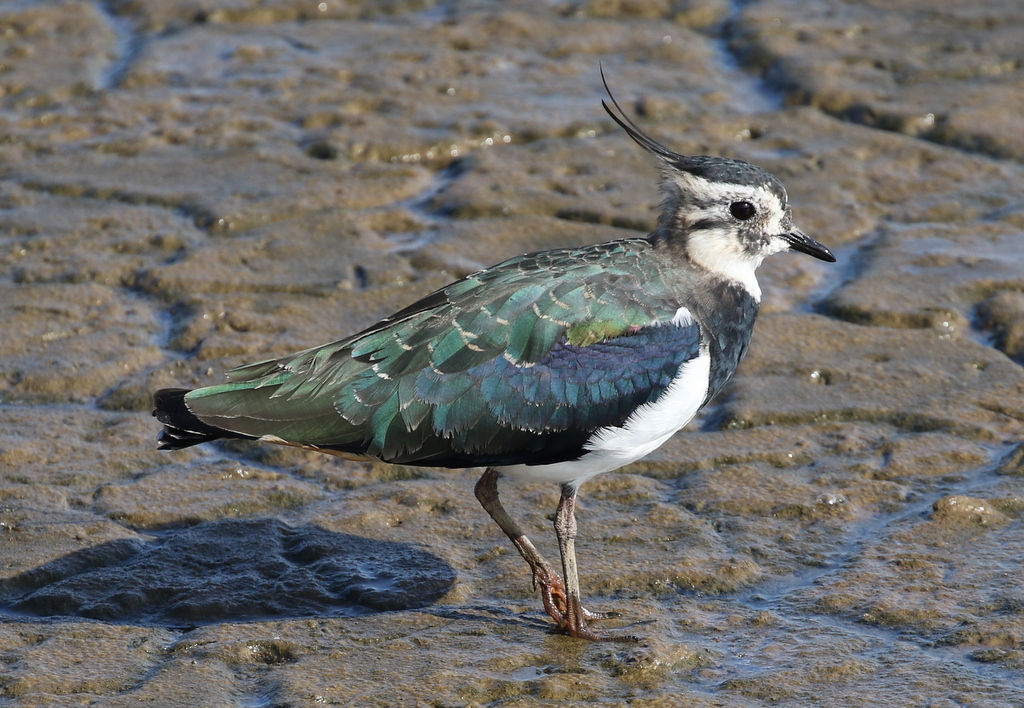 Lapwing – at the front of Volunteer Marsh, looking stunning in the sunshine
Lapwing – at the front of Volunteer Marsh, looking stunning in the sunshine
A Curlew and a juvenile Bar-tailed Godwit were feeding between the main path and Parrinder Hide, giving a good view of the two species. A Black-tailed Godwit was feeding in the channel, just below the path. It was still moulting out of breeding plumage, with lots of rusty feathers still below and .dark centred feathers in its upperparts. As we walked towards it, the Black-tailed Godwit looked nervous, and walked up the muddy bank into the edge of the saltmarsh. It wasn’t us, as a Hobby flew in across the Volunteer Marsh just at that point, continuing on over Parrinder Hide and disappeared from view.
 Black-tailed Godwit – still moulting out of rusty breeding plumage
Black-tailed Godwit – still moulting out of rusty breeding plumage
As we got to the channel at the far end of Volunteer Marsh, there were several more godwits. This time there were two more of each – 2 Black-tailed Godwits and 2 Bar-tailed Godwits. We had a great view of the two species side by side.
 Bar-tailed Godwit – 1 of 2 on the near edge of Volunteer Marsh today
Bar-tailed Godwit – 1 of 2 on the near edge of Volunteer Marsh today
Out at the Tidal Pools, there were yet more waders – more Black-tailed Godwits and Redshanks. There was a small roost of waders on one of the spits – Grey Plovers, Turnstones and a single Knot, an adult still moulting out of breeding plumage, still sporting quite a lot of orange on its underparts.
 Waders – roosting out on the Tidal Pools over high tide
Waders – roosting out on the Tidal Pools over high tide
Part of the reason we had gone straight out to the beach was to try to see a Purple Sandpiper which had been roosting on the old concrete bunker out on the sand. Unfortunately, when we got there, we found six or seven kids climbing all over it. Needless to say, the Purple Sandpiper had gone. We scanned the mussel beds at the bottom of the beach, just in case it had gone that way, but we only found more Bar-tailed Godwits, Curlew, Turnstone and Oystercatchers. The sea was flat calm and we managed to find a Great Crested Grebe and two Common Scoter out on the water.
We didn’t stay long out at the beach, but headed back to Parrinder Hide instead. A couple of Common Snipe were feeding along the edge just to the left of the hide. One flew across and landed in the vegetation the other side, but the other stayed put and worked its way gradually towards us, giving us a great view of it. The two Little Stints were still out on the edge of the islands.
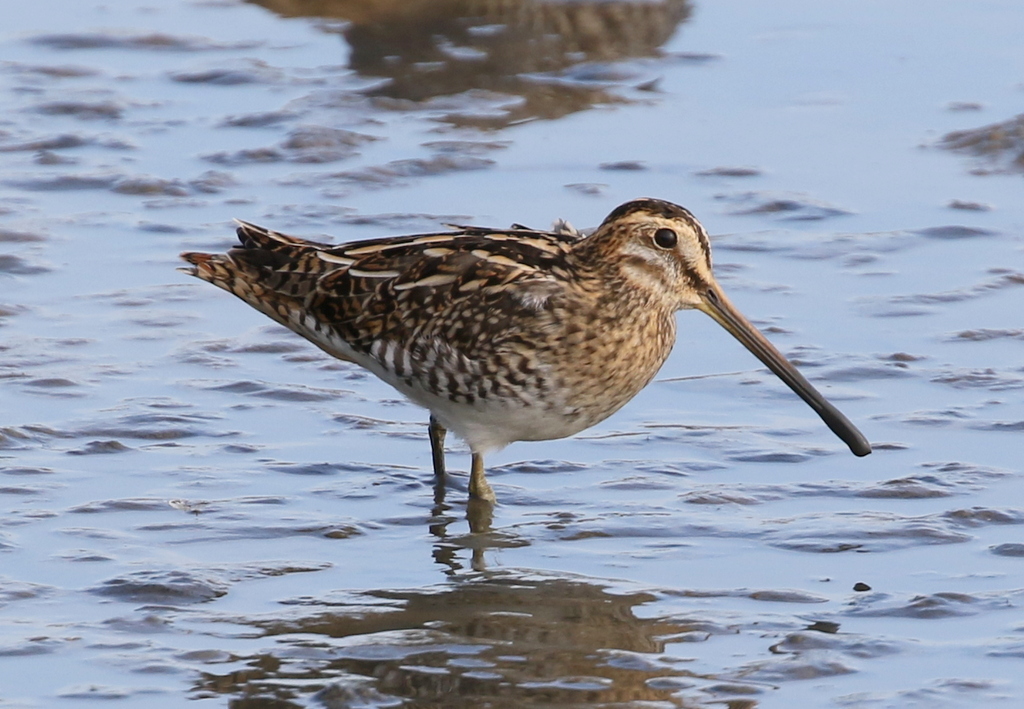 Common Snipe – showing very well from Parrinder Hide
Common Snipe – showing very well from Parrinder Hide
Lots of Black-headed Gulls started flying in to bathe, but despite looking through them carefully there was nothing different in with them today. There was a scattering of Linnets, Meadow Pipits and Pied Wagtails around the islands. A Hobby flashed past again, this time low down right in front of the hide. Stunning!
While we were out at the beach, the Yellow-browed Warbler had been reported again in the picnic area. We walked back to see if we could catch up with it, but there was no sign of the tit flock it had reportedly been with. We walked round via the entrance track and round the trees to see if we could relocate it, but we couldn’t. We made our way back to the picnic area, to see if anything might reappear. We sat there for a while and rested our weary legs for a while, scanning the trees to see if wither would come in. But there was still no sign. A Red Kite drifted over.
 Red Kite – drifted over the picnic area late afternoon
Red Kite – drifted over the picnic area late afternoon
Finally, we had to call it a day and head for home. It had been a great three days, with a good total of birds seen, including several nice rare or scarce species. Great stuff!
